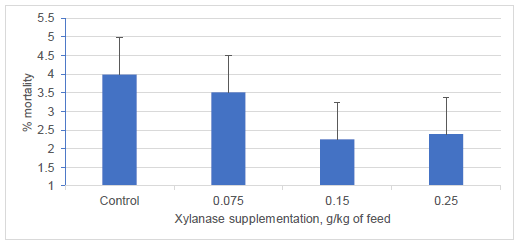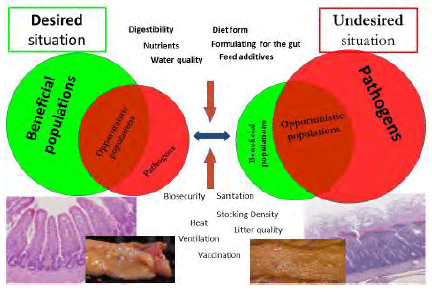Inherent digestive tract insufficiency in monogastric animals: culpability of the gut microbiome and dietary approaches for optimizing intestinal health
Although pigs and poultry are highly efficient in converting feed to food products, they still excrete significant amounts of undigested nutrients. For example, broilers lose almost 25-30% of ingested dry matter, 20-25% of gross energy, 30-50% of nitrogen and 45-55% of phosphorus intake in the manure. Undigested nutrients have negative implications on production efficiency, profitability and sustainability of farm operations. Moreover, the undigested nutrients serve as substrates for enteric pathogens with implications to animal (e.g. E. coli, clostridia) health and human (e.g. salmonella, campylobacter) health via contained animal products. The peculiarity is that feedstuffs contain anti-nutritional factors (ANF) such as phytic acid or fractions that are not degraded sufficiently or indeed at all by the conditions and the array of digestive enzymes in the gastrointestinal tract. Moreover, the newly hatched chicks and weaned piglets have limited capacity to express endogenous enzymes. Arguably with restriction on use of preventive antibiotics, there is need to explore and implement alternative dietary approaches to enhance digestive function. Supplemental feed enzymes improve nutrient utilization linked to reduced nutrients excretion and enteric pathogen load. Moreover, nutritional strategies for stimulating juvenile gut maturation (e.g. epidermal growth factor, feed structure), nurturing favorable gut microflora (e.g. probiotics, prebiotic), suppressing enteric pathogens (e.g. organic acids, low crude protein diets) and maintaining intestinal integrity (e.g. yeast metabolites) should be integral in AGP free feeding programs. These dietary approaches in combination with improvements in management, vaccination programs and/or genetics will be effective in optimizing growth performance of poultry and pigs raised without or with reduced antibiotics for growth promotion.




Agyekum, A. K., B. A. Slominski, and C. M. Nyachoti. 2012. Organ weight, intestinal morphology, and fasting whole-body oxygen consumption in growing pigs fed diets containing distillers dried grains with solubles alone or in combination with a multienzyme supplement. J Anim Sci 90(9):3032-3040. doi: 10.2527/jas.2011-4380
Antoniou, T. C., and R. R. Marquardt. 1982. Utilization of Rye Diets by Chicks as Affected by Lipid Type and Level and Penicillin Supplementation. Poultry Sci 61(1):107-116.
Apajalahti, J., A. Kettunen, and H. Graham. 2004. Characteristics of the gastrointestinal microbial communities, with special reference to the chicken. World Poultry Sci J 60(2):223-232. doi: 10.1079/Wps200415
Apajalahti, J., A. Kettunen, and H. Graham. 2007. Characteristics of the gastrointestinal microbial communities, with special reference to the chicken. World's Poultry Science Journal 60(2):223-232. doi: 10.1079/WPS200415
Aviagen. 2019. Ross 708 broiler: Performance objectives. p 16. Aviagen, Huntsville, AL. Bedford, M. R. 2018. The evolution and application of enzymes in the animal feed industry: the role of data interpretation. Brit Poultry Sci 59(5):486-493. doi: 10.1080/00071668.2018.1484074
Bedford, M. R., and A. J. Cowieson. 2012. Exogenous enzymes and their effects on intestinal microbiology. Animal Feed Science and Technology 173(1-2):76-85.
Cant, J. P., B. W. McBride, and W. J. Croom. 1996. The regulation of intestinal metabolism and its impact on whole animal energetics. Journal of Animal Science 74(10):2541-2553.
Collet, S. 2012. The “Seed, Feed and Weed” approach to managing intestinal health in drug free production systems The poultry informed professional No. 124, University of Georgia.
Corrigan, A., M. de Leeuw, S. Penaud-Frezet, D. Dimova, and R. A. Murphy. 2015. Phylogenetic and functional alterations in bacterial community compositions in broiler ceca as a result of mannan oligosaccharide supplementation. Appl Environ Microbiol 81(10):3460-3470. doi: 10.1128/AEM.04194-14
Courtin, C. M., W. F. Broekaert, K. Swennen, O. Lescroart, O. Onagbesan, J. Buyse, E. Decuypere, T. Van de Wiele, M. Marzorati, W. Verstraete, G. Huyghebaert, and J. A. Delcour. 2008. Dietary inclusion of wheat bran arabinoxylooligosaccharides induces beneficial nutritional effects in chickens. Cereal Chem 85(5):607-613. doi: 10.1094/Cchem-85-5-0607
Drew, M. D., N. A. Syed, B. G. Goldade, B. Laarveld, and A. G. Van Kessel. 2004. Effects of dietary protein source and level on intestinal populations of Clostridium perfringens in broiler chickens. Poult Sci 83(3):414-420.
Ferket, P. R. 2012. Embryo epigenomic response to breeder management and nutrition XXIV World's Poultry Congress. p 1-11, Salvador, Bahia, Brazil.
Friedman, A., O. Elad, I. Cohen, and E. Bar Shira. 2012. The Gut Associated Lymphoid System in the Post-Hatch Chick: Dynamics of Maternal IgA. Isr J Vet Med 67(2):75-81.
Gibson, G. R., and M. B. Roberfroid. 1995. Dietary Modulation of the Human Colonic Microbiota - Introducing the Concept of Prebiotics. J Nutr 125(6):1401-1412.
Giron, J. A., A. G. Torres, E. Freer, and J. B. Kaper. 2002. The flagella of enteropathogenic Escherichia coli mediate adherence to epithelial cells. Mol Microbiol 44(2):361-379.
Gous, R. M. 2010. Nutritional limitations on growth and development in poultry. Livest Sci 130(1-3):25-32. doi: 10.1016/j.livsci.2010.02.007
Havenstein, G. B., P. R. Ferket, and M. A. Qureshi. 2003. Growth, livability, and feed conversion of 1957 versus 2001 broilers when fed representative 1957 and 2001 broiler diets. Poultry Sci 82(10):1500-1508.
Heo, J. M., F. O. Opapeju, J. R. Pluske, J. C. Kim, D. J. Hampson, and C. M. Nyachoti. 2013. Gastrointestinal health and function in weaned pigs: a review of feeding strategies to control post-weaning diarrhoea without using in-feed antimicrobial compounds. J Anim Physiol Anim Nutr (Berl) 97(2):207-237. doi: 10.1111/j.1439-0396.2012.01284.x
Kaldhusdal, M., and E. Skjerve. 1996. Association between cereal contents in the diet and incidence of necrotic enteritis in broiler chickens in Norway. Preventive Veterinary Medicine 28(1):1-16. doi: https://doi.org/10.1016/0167-5877(96)01021-5
Kiarie, E., S. Bhandari, D. O. Krause, M. Scott, and C. M. Nyachoti. 2010. Weaned piglet responses to Escherichia coli K88+ oral challenge when fed diets containing a S. cerevisiae fermentation product with or without in-feed antibiotics. Journal of animal science 88 (E-Suppl. 2):653(Abstr.).
Kiarie, E., S. Bhandari, M. Scott, D. O. Krause, and C. M. Nyachoti. 2011. Growth performance and gastrointestinal microbial ecology responses of piglets receiving Saccharomyces cerevisiae fermentation products after an oral challenge with Escherichia coli (K88). J Anim Sci 89(4):1062-1078. doi: 10.2527/jas.2010-3424.
Kiarie, E., L. F. Romero, and C. M. Nyachoti. 2013. The role of added feed enzymes in promoting gut health in swine and poultry. Nutr Res Rev 26(1):71-88. doi: 10.1017/S0954422413000048.
Kiarie, E., M. Scott, D. O. Krause, H. Khazanehei, E. Khafipour, and C. M. Nyachoti. 2012. Interactions of Saccharomyces cerevisiae fermentation product and in-feed antibiotic on gastrointestinal and immunological responses in piglets challenged with Escherichia coli K88+. J Anim Sci 90 Suppl 4:1-3. doi: 10.2527/jas.52977.
Kiarie, E., C. Voth, D. Wey, C. Zhu, P. Vingerhoeds, S. Borucki, and E. J. Squires. 2018. Comparative efficacy of antibiotic growth promoter and benzoic acid on growth performance, nutrient utilization, and indices of gut health in nursery pigs fed corn–soybean meal diet. Can J Anim Sci 98(4):868-874. doi: 10.1139/cjas-2018-0056.
Kiarie, E., F. Waikibia, G. Kamande, and C. M. Nyachoti. 2019a. Utility of Saccharomyces cerevisiae fermentation product in pig feeding programs: amelioration of deleterious effects of enteric bacterial pathogens. In: Animal Production Soceity of Kenya (APSK) 2019 Scientific Symposium, Hotel Waterbuck, Nakuru, Kenya. p 41-45.
Kiarie, E., M. C. Walsh, and C. M. Nyachoti. 2016. Performance, digestive function, and mucosal responses to selected feed additives for pigs. J Anim Sci 94(supplement3):169-180. doi: 10.2527/jas.2015-9835.
Kiarie, E., M. C. Walsh, L. F. Romero, X. Yang, and S. K. Baidoo. 2015. Comparative efficacy of a blend of multiple enzymes and an in-feed antibiotic on growth performance and apparent digestibility of energy and protein in nursery pigs. Animal Production Science 55:1540.
Kiarie, E. G., H. Leung, R. Akbari Moghaddam Kakhki, R. Patterson, and J. R. Barta. 2019b. Utility of Feed Enzymes and Yeast Derivatives in Ameliorating Deleterious Effects of Coccidiosis on Intestinal Health and Function in Broiler Chickens. Frontiers in Veterinary
Science 6(473)(Review) doi: 10.3389/fvets.2019.00473.
Kiarie, E. G., and A. Mills. 2019. Role of Feed Processing on Gut Health and Function in Pigs and Poultry: Conundrum of Optimal Particle Size and Hydrothermal Regimens. Frontiers in Veterinary Science 6(19)(Review) doi: 10.3389/fvets.2019.00019.
Kim, E., H. Leung, N. Akhtar, J. Li, J. R. Barta, Y. Wang, C. Yang, and E. Kiarie. 2017. Growth performance and gastrointestinal responses of broiler chickens fed corn-soybean meal diet without or with exogenous epidermal growth factor upon challenge with Eimeria. Poultry Sci 96(10):3676-3686.
Krupa, E., Z. Krupová, M. Wolfová, and E. Žáková. 2017. Estimation of economic values for traits of pig breeds in different breeding systems: II. Model application to a three-way crossing system. Livest Sci 205:70-78. doi: 10.1016/j.livsci.2017.09.018.
Leung, H., A. Yitbarek, R. Snyder, R. Patterson, J. R. Barta, N. Karrow, and E. Kiarie. 2019. Responses of broiler chickens to Eimeria challenge when fed a nucleotide-rich yeast extract1. Poultry Sci:pey533-pey533. doi: 10.3382/ps/pey533.
Lindemann, M. D., S. G. Cornelius, S. M. el Kandelgy, R. L. Moser, and J. E. Pettigrew. 1986. Effect of age, weaning and diet on digestive enzyme levels in the piglet. J Anim Sci 62(5):1298-1307.
Marquardt, R. R., A. T. Ward, and R. Misir. 1979. The Retention of Nutrients by Chicks Fed Rye Diets Supplemented with Amino Acids and Penicillin. Poultry Sci 58(3):631-640. doi: https://doi.org/10.3382/ps.0580631.
Mateos, G. G., E. Jimenez-Moreno, M. P. Serrano, and R. P. Lazaro. 2012. Poultry response to high levels of dietary fiber sources varying in physical and chemical characteristics. J Appl Poultry Res 21(1):156-174. doi: 10.3382/japr.2011-00477.
Merks, J. W. M. 2018. One century of genetic changes in pigs and the future needs. BSAP Occasional Publication 27:8-19. doi: 10.1017/S1463981500040498.
Mirelman, D., G. Altmann, and Y. Eshdat. 1980. Screening of bacterial isolates for mannosespecific lectin activity by agglutination of yeasts. J Clin Microbiol 11(4):328-331. .
Munyaka, P. M., N. K. Nandha, E. Kiarie, C. M. Nyachoti, and E. Khafipour. 2016. Impact of combined beta-glucanase and xylanase enzymes on growth performance, nutrients utilization and gut microbiota in broiler chickens fed corn or wheat-based diets. Poult Sci 95(3):528-540. doi: 10.3382/ps/pev333.
Neijat, M., J. Habtewold, R. B. Shirley, A. Welsher, J. Barton, P. Thiery, and E. Kiarie. 2019. Bacillus subtilis Strain DSM 29784 Modulates the Cecal Microbiome, Concentration of Short-Chain Fatty Acids, and Apparent Retention of Dietary Components in Shaver White Chickens during Grower, Developer, and Laying Phases. Appl Environ Microb 85(14):e00402-00419. doi: 10.1128/aem.00402-19.
NRC. 1994. Nutrient Requirements of Poultry. 9th revision ed. National Academy of Sciences Press, Washington, D.C.
NRC. 2012. Nutrient Requirements of Swine. 11th revision ed. National Academy of Sciences Press, Washington, D.C.
Nurmi, E., and M. Rantala. 1973. New aspects of Salmonella infection in broiler production. Nature 241(5386):210-211.
Nyachoti, C. M., F. O. Omogbenigun, M. Rademacher, and G. Blank. 2006. Performance responses and indicators of gastrointestinal health in early-weaned pigs fed low-protein amino acid-supplemented diets. J Anim Sci 84(1):125-134.
Oakley, B. B., H. S. Lillehoj, M. H. Kogut, W. K. Kim, J. J. Maurer, A. Pedroso, M. D. Lee, S. R. Collett, T. J. Johnson, and N. A. Cox. 2014. The chicken gastrointestinal microbiome. FEMS Microbiol Lett 360(2):100-112. doi: 10.1111/1574-6968.12608.
Parenteau, I. A., M. Stevenson, and E. G. Kiarie. 2020. Egg production and quality responses to increasing isoleucine supplementation in Shaver white hens fed a low crude protein cornsoybean meal diet fortified with synthetic amino acids between 20 and 46 weeks of age. Poultry Sci 99(3):1444-1453. doi: https://doi.org/10.1016/j.psj.2019.10.064.
Patterson, J. A., and K. M. Burkholder. 2003. Application of prebiotics and probiotics in poultry production. Poultry Sci 82(4):627-631.
Pluske, J. R. 2016. Invited review: Aspects of gastrointestinal tract growth and maturation in the pre- and postweaning period of pigs. Journal of Animal Science 94:399-411. doi: 10.2527/jas2015-9767.
Pluske, J. R., D. W. Pethick, D. E. Hopwood, and D. J. Hampson. 2002. Nutritional influences on some major enteric bacterial diseases of pig. Nutr Res Rev 15(2):333-371. doi: 10.1079/NRR200242.
Ravindran, V. 2012. Advances and Future Directions in Poultry Nutrition: An Overview. Korean J Poult Sci 39:53-62. .
Slominski, B. A. 2011. Recent advances in research on enzymes for poultry diets. Poult Sci 90(9):2013-2023. doi: 10.3382/ps.2011-01372.
Smulders, A. C. J. M., Veldman A. and Enting H. 1999. Effect of anti-microbial growth promoter in feeds with different levels of indigestible protein on broiler performance. In: 12th European Symposium on Poultry Nutrition, Veldhaven, The Netherlands.
Stanley, D., M. S. Geier, R. J. Hughes, S. E. Denman, and R. J. Moore. 2013. Highly Variable Microbiota Development in the Chicken Gastrointestinal Tract. Plos One 8(12)doi: ARTN e84290.
Sunkara, L. T., M. Achanta, N. B. Schreiber, Y. R. Bommineni, G. Dai, W. Jiang, S. Lamont, H. S. Lillehoj, A. Beker, R. G. Teeter, and G. Zhang. 2011. Butyrate enhances disease resistance of chickens by inducing antimicrobial host defense peptide gene expression. PLoS One 6(11):e27225. doi: 10.1371/journal.pone.0027225.
Timbermont, L., F. Haesebrouck, R. Ducatelle, and F. Van Immerseel. 2011. Necrotic enteritis in broilers: an updated review on the pathogenesis. Avian Pathology 40(4):341-347. doi: 10.1080/03079457.2011.590967.
Uni, Z., and R. P. Ferket. 2004. Methods for early nutrition and their potential. World Poultry Sci J 60(1):101-111. doi: 10.1079/Wps20038.
Urriola, P. E., and H. H. Stein. 2012. Comparative digestibility of energy and nutrients in fibrous feed ingredients fed to Meishan and Yorkshire pigs. J Anim Sci 90(3):802-812. doi: 10.2527/jas.2010-3254.
Waititu, S. M., A. Yitbarek, E. Matini, H. Echeverry, E. Kiarie, J. C. Rodriguez-Lecompte, and C. M. Nyachoti. 2014. Effect of supplementing direct-fed microbials on broiler performance, nutrient digestibilities, and immune responses. Poultry Sci 93(3):625-635. doi: 10.3382/ps.2013-03575.
Wealleans, A. L., M. C. Walsh, L. F. Romero, and V. Ravindran. 2017. Comparative effects of two multi-enzyme combinations and a Bacillus probiotic on growth performance, digestibility of energy and nutrients, disappearance of non-starch polysaccharides, and gut microflora in broiler chickens. Poultry Sci 96(12):4287-4297. doi: 10.3382/ps/pex226.
Xu, Y., C. R. Stark, P. R. Ferket, C. M. Williams, W. J. Pacheco, and J. Brake. 2015. Effect of dietary coarsely ground corn on broiler live performance, gastrointestinal tract development, apparent ileal digestibility of energy and nitrogen, and digesta particle size distribution and retention time. Poultry Sci 94(1):53-60. doi: 10.3382/ps/peu015.
Zier-Rush, C. E., C. Groom, M. Tillman, J. Remus, and R. D. Boyd. 2016. The feed enzyme xylanase improves finish pig viability and carcass feed efficiency. Journal of Animal Science 94:115-115. doi: 10.2527/msasas2016-244






.jpg&w=3840&q=75)